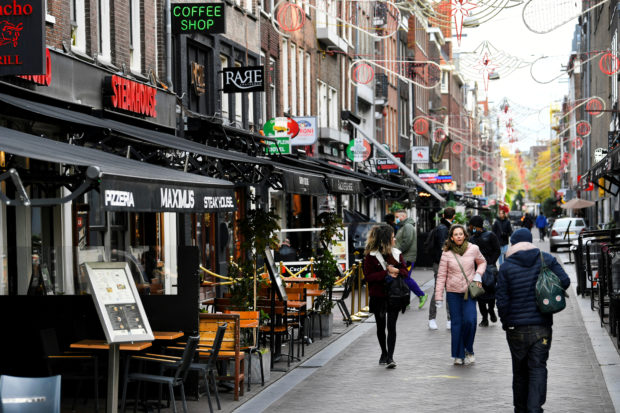Belgium, Netherlands major cocaine hubs–Europol

People walk past shuttered restaurants and bars during the resurging coronavirus outbreak in Amsterdam, Netherlands, October 14 2020. REUTERS FILE PHOTO
THE HAGUE — Belgium and the Netherlands have become major hubs for cocaine trafficking into Europe, overtaking Spain as the primary smuggling route, the EU’s policing agency said Tuesday.
Cashing in on increased cocaine supplies, notably from Colombia, criminal gangs are using the port cities of Rotterdam, Hamburg and especially Antwerp to ship in the drug to the Netherlands, from where it is distributed across Europe, Europol said.
“The epicentre of the cocaine market in Europe has shifted northwards,” said Europol, which produced a 27-page report with the UN’s Vienna-based drug and crime office (UNODC).
“The increased use of containerized shipments relying on the high-volume ports of Antwerp, Rotterdam and Hamburg has consolidated the role of the Netherlands as a staging point.”
This has “led to continental Europe’s North Sea coast overtaking the Iberian peninsula as the primary point of entry for cocaine reaching Europe,” the report said.
Article continues after this advertisementLast year alone, cocaine seizures in Antwerp totaled some 65.6 tonnes, Europol said in the “Cocaine Insights” report.
Article continues after this advertisementIn February, Germany and Belgium seized 23 tonnes in a record haul. They were stashed in shipping containers.
Europe’s cocaine market was largely boosted by increased supplies, particularly from Colombia where a 2016 peace deal with the leftist FARC guerilla group left the market splintered and open to increased competition.
The FARC controlled a portion of the area under coca cultivation and regulated access to the cocaine supply available to brokers and international traffickers, the report said.
“The peace agreement resulted in the end of FARC’s integrated command structure and the emergence of various splinter groups exercising control over different regions and the cocaine production therein,” it said.
This in turn “multiplied the potential for the formation of new alliances and partnerships,” the report added.
Meanwhile, European drug gangs changed strategy, forming alliances with these groups “thereby cutting out the middle-man” and getting cocaine directly from the source, the report said.
European drug gangs often operated along family, ethnic or linguistic lines including Moroccan and Albanian drug gangs as well as Italy’s ‘Ndrangheta mafia group, the report said.
Cocaine has become purer and since 2012 were rivaling US imports for quality, the report said.
After cannabis, cocaine is now the second-most popular drug in Western and Central Europe, with the most recent estimates suggesting some 4.4 million users over the past year, the report said.